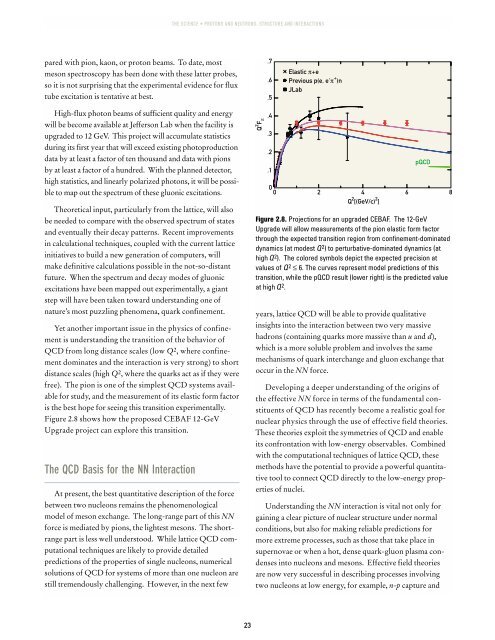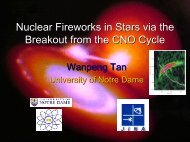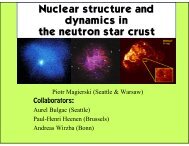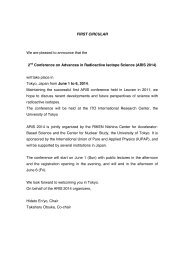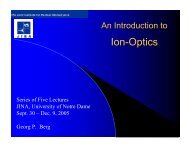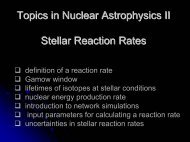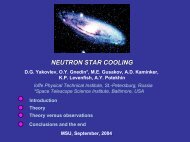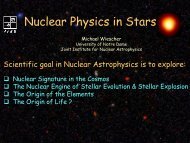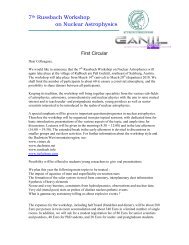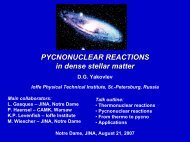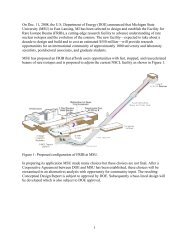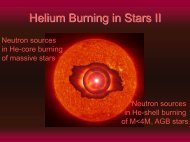OPPORTUNITIES IN NUCLEAR SCIENCE A Long-Range Plan for ...
OPPORTUNITIES IN NUCLEAR SCIENCE A Long-Range Plan for ...
OPPORTUNITIES IN NUCLEAR SCIENCE A Long-Range Plan for ...
You also want an ePaper? Increase the reach of your titles
YUMPU automatically turns print PDFs into web optimized ePapers that Google loves.
THE <strong>SCIENCE</strong> • PROTONS AND NEUTRONS: STRUCTURE AND <strong>IN</strong>TERACTIONS<br />
pared with pion, kaon, or proton beams. To date, most<br />
meson spectroscopy has been done with these latter probes,<br />
so it is not surprising that the experimental evidence <strong>for</strong> flux<br />
tube excitation is tentative at best.<br />
.7<br />
.6<br />
.5<br />
Elastic π+e<br />
Previous p(e, e'π + )n<br />
JLab<br />
High-flux photon beams of sufficient quality and energy<br />
will be become available at Jefferson Lab when the facility is<br />
upgraded to 12 GeV. This project will accumulate statistics<br />
during its first year that will exceed existing photoproduction<br />
data by at least a factor of ten thousand and data with pions<br />
by at least a factor of a hundred. With the planned detector,<br />
high statistics, and linearly polarized photons, it will be possible<br />
to map out the spectrum of these gluonic excitations.<br />
Theoretical input, particularly from the lattice, will also<br />
be needed to compare with the observed spectrum of states<br />
and eventually their decay patterns. Recent improvements<br />
in calculational techniques, coupled with the current lattice<br />
initiatives to build a new generation of computers, will<br />
make definitive calculations possible in the not-so-distant<br />
future. When the spectrum and decay modes of gluonic<br />
excitations have been mapped out experimentally, a giant<br />
step will have been taken toward understanding one of<br />
nature’s most puzzling phenomena, quark confinement.<br />
Yet another important issue in the physics of confinement<br />
is understanding the transition of the behavior of<br />
QCD from long distance scales (low Q 2 , where confinement<br />
dominates and the interaction is very strong) to short<br />
distance scales (high Q 2 , where the quarks act as if they were<br />
free). The pion is one of the simplest QCD systems available<br />
<strong>for</strong> study, and the measurement of its elastic <strong>for</strong>m factor<br />
is the best hope <strong>for</strong> seeing this transition experimentally.<br />
Figure 2.8 shows how the proposed CEBAF 12-GeV<br />
Upgrade project can explore this transition.<br />
The QCD Basis <strong>for</strong> the NN Interaction<br />
At present, the best quantitative description of the <strong>for</strong>ce<br />
between two nucleons remains the phenomenological<br />
model of meson exchange. The long-range part of this NN<br />
<strong>for</strong>ce is mediated by pions, the lightest mesons. The shortrange<br />
part is less well understood. While lattice QCD computational<br />
techniques are likely to provide detailed<br />
predictions of the properties of single nucleons, numerical<br />
solutions of QCD <strong>for</strong> systems of more than one nucleon are<br />
still tremendously challenging. However, in the next few<br />
Q 2 F π<br />
.4<br />
.3<br />
.2<br />
.1<br />
0<br />
0 2<br />
4 6<br />
Q 2 [(GeV/c) 2 ]<br />
pQCD<br />
Figure 2.8. Projections <strong>for</strong> an upgraded CEBAF. The 12-GeV<br />
Upgrade will allow measurements of the pion elastic <strong>for</strong>m factor<br />
through the expected transition region from confinement-dominated<br />
dynamics (at modest Q 2 ) to perturbative-dominated dynamics (at<br />
high Q 2 ). The colored symbols depict the expected precision at<br />
values of Q 2 ≤ 6. The curves represent model predictions of this<br />
transition, while the pQCD result (lower right) is the predicted value<br />
at high Q 2 .<br />
years, lattice QCD will be able to provide qualitative<br />
insights into the interaction between two very massive<br />
hadrons (containing quarks more massive than u and d),<br />
which is a more soluble problem and involves the same<br />
mechanisms of quark interchange and gluon exchange that<br />
occur in the NN <strong>for</strong>ce.<br />
Developing a deeper understanding of the origins of<br />
the effective NN <strong>for</strong>ce in terms of the fundamental constituents<br />
of QCD has recently become a realistic goal <strong>for</strong><br />
nuclear physics through the use of effective field theories.<br />
These theories exploit the symmetries of QCD and enable<br />
its confrontation with low-energy observables. Combined<br />
with the computational techniques of lattice QCD, these<br />
methods have the potential to provide a powerful quantitative<br />
tool to connect QCD directly to the low-energy properties<br />
of nuclei.<br />
Understanding the NN interaction is vital not only <strong>for</strong><br />
gaining a clear picture of nuclear structure under normal<br />
conditions, but also <strong>for</strong> making reliable predictions <strong>for</strong><br />
more extreme processes, such as those that take place in<br />
supernovae or when a hot, dense quark-gluon plasma condenses<br />
into nucleons and mesons. Effective field theories<br />
are now very successful in describing processes involving<br />
two nucleons at low energy, <strong>for</strong> example, n-p capture and<br />
8<br />
23


